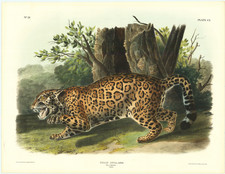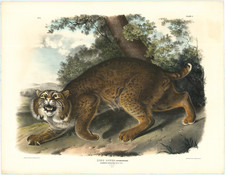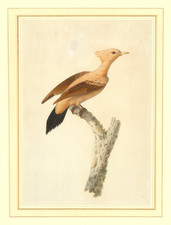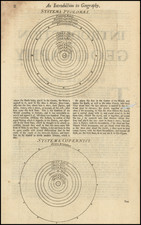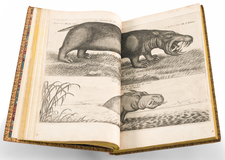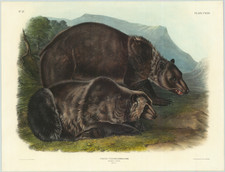Canvas backed Duck. Fulligula Vallisneria. Steph. 1, 2, Male, 3, Female. View of Baltimore, drawn from nature by John James Audubon and rendered in chromolithography by J. Bien in New York, 1860, is a compelling portrayal of avian elegance set against the historical backdrop of Baltimore. The chromolithograph showcases three striking canvas-backed ducks in the foreground, with a vivid depiction of Baltimore across the water, offering a harmonious blend of ornithological precision and scenic beauty.
The canvasback duck (Aythya valisineria) is a North American diving duck distinguished by its unique sloping profile. With a long, tapered bill and a striking red head sitting atop a white back and neck, this duck is easily recognizable and admired by both bird enthusiasts and waterfowl hunters. Primarily inhabiting freshwater lakes, rivers, and marshes, the canvasback's diet consists largely of aquatic plants, particularly wild celery, from which its scientific name is derived. Over the years, factors such as habitat loss and hunting have led to fluctuations in its population, making conservation efforts crucial to ensuring its continued survival.
The presence of Baltimore in the background is emblematic of the intricate relationship between the natural world and human civilization. Baltimore, a burgeoning city of the mid-19th century, known for its rich history and vibrant port, serves not only as a geographical point of reference but also as a nod to Audubon's personal experiences. His acknowledgment of Baltimore's hospitality and the city's citizens' generosity during a particularly trying episode of political unrest further deepens the historical significance of the piece. In the Ornithological Biography, Audubon explains his reason for including the view of Baltimore:
In the Plate are represented two Males and a Female. In the background is a view of Baltimore, which I have had great pleasure in in- troducing, on account of the hospitality which I have there experien- ced, and the generosity of its inhabitants, who, on the occasion of a quantity of my plates having been destroyed by the mob during an outburst of political feeling, indemnified me for the loss.
Moreover, the plate's ornithological details, representing two males and a female of the species, align with Audubon's comprehensive documentation found in his Ornithological Biography. His commitment to capturing each bird in its natural environment, based on firsthand observation, underlines the exacting nature of his work. This plate, beyond its evident aesthetic appeal, is an encapsulation of a time, a place, and a man's undying passion for the natural world, making it a significant artifact for those seeking insight into 19th-century America's scientific and cultural tapestry.
Birds of America: The Bien Edition
The legacy of John James Audubon's Birds of America is one of unbridled passion for ornithology and artistry, a blend of meticulous observation with artistic flair. While the original "Double Elephant Folio" edition is justifiably celebrated for its monumental contribution to ornithology and fine art printing, it is the lesser-known Bien Edition that stands as an equally impressive testament to the evolution of printing technology and the continued appreciation of Audubon’s work.
Julius Bien (1826-1909) was a German-born American lithographer and cartographer, renowned for his significant contributions to American cartography during the 19th century. Born on September 27, 1826, in Naumburg, Germany, Bien originally trained in his homeland, mastering the nascent craft of chromolithography, a method for producing multi-color prints.
In the 1850s, Bien emigrated to the United States, where he set up his own lithography firm, Julius Bien & Co., in New York. His innovative techniques and meticulous attention to detail quickly earned him a reputation as one of the country's leading lithographers. The firm became known for its wide range of work, from maps and atlases to commercial prints and illustrations.
One of Bien's most significant collaborations was with the U.S. government, particularly the U.S. Geological Survey (USGS). In the late 19th century, the USGS undertook the ambitious project of mapping the entire United States. Bien's firm was responsible for producing many of these topographical maps, and he introduced advanced printing techniques that enhanced their clarity, precision, and detail.
However, not all of Bien's ventures were successful. His attempt at reproducing a double elephant folio edition of Audubon's Birds of America in the 1860s, for instance, was left incomplete due to financial challenges posed by the Civil War. Despite this, many of the plates he did produce for this edition are considered masterpieces of chromolithography.
Julius Bien passed away on December 21, 1909, in New York. His contributions to lithography and cartography in the U.S. left a lasting legacy, with many of his techniques becoming standard practice in the field. His maps, in particular, serve as a testament to the evolving understanding and depiction of the American landscape during a period of rapid westward expansion and scientific exploration.
John James Audubon (1785-1851), born Jean-Jacques Rabin in Haiti on April 26, 1785, was a Franco-American ornithologist, naturalist, and painter, celebrated for his detailed illustrations of North American birds in their natural habitats. His major work, a color-plate book titled The Birds of America, is considered one of the finest ornithological works ever produced.
Audubon's early years were shaped by tumultuous events. Born out of wedlock in the French Caribbean colony of Saint-Domingue (now Haiti) to a Creole mother and a French sea captain, he was smuggled to Nantes, France, during a slave rebellion. There, he was adopted by his father and stepmother and raised as their own. His childhood in France was filled with outdoor adventures and initial forays into drawing.
In 1803, to avoid conscription into Napoleon's army, he was sent to America, where he managed one of his father's estates near Philadelphia. This move further kindled his profound interest in the wildlife of the New World. Despite a few failed business ventures and challenges, Audubon remained committed to his passion for nature and art.
His dream to document all of the birds of America began to take form in the 1810s. Travelling through America's wilderness, Audubon observed, hunted, and painted birds. He developed a particular technique that involved wiring freshly killed birds into a natural pose on a board. This innovative method combined with his keen observation allowed him to create more lifelike illustrations than many of his contemporaries.
Failing to secure American subscribers or a publisher for his extensive collection, Audubon traveled to the United Kingdom in 1826. There, The Birds of America was met with critical acclaim. Between 1827 and 1838, this work was published in sections, comprising 435 hand-colored, life-sized prints made from engraved plates.
Audubon followed this success with a companion work, Ornithological Biography, which provided detailed narratives about each species. His later work included studies of American mammals, and he became one of the founding members of the New-York Historical Society.
Despite facing numerous challenges throughout his life, including financial hardships and criticism from some peers, Audubon's dedication to his work resulted in an invaluable contribution to ornithology and American art. He died on January 27, 1851, in New York City. Today, his legacy continues, notably through the National Audubon Society, which promotes conservation and appreciation of birds and their habitats.









